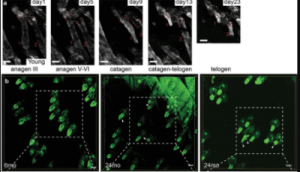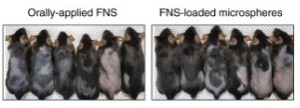Dr. Rui Yi and his team from Northwestern University’s YiLab just published a groundbreaking new paper explaining the reason for aging related hair loss. The current findings were shown in various mammals.

The Great Stem Cell Escape
The findings in this paper suggest that hair loss is not caused by stem cell death, depletion and exhaustion as has long been postulated. Rather, the stem cells escape from the structures that house them (i.e., the hair follicle bulge). The New York Times has an in-depth summary of these very interesting findings. Also see another take from Futurism.
In order to flee, the cells change their shapes from round to amoeba-like structures. Then they squeeze out of tiny holes in the follicle. Finally, they recover their normal shapes and dart away!
Of note, the researchers (led by Dr. Yi and his PhD student Chi Zhang) discovered two genes (Foxc1 and Nfatc1) that were less active in older aging hair follicle cells. The role of these two genes is to to “imprison” stem cells in the bulge. Note that Foxc1 stands for Forkhead Box C1. Nfatc1 stands for Nuclear Factor of Activated T Cells 1.
This study found a “hitherto unknown activity” of epithelial cells escaping from their niche during the aging process. This escape subsequently leads to stem cell degradation.
“If I did not see it for myself I would not have believed it. It’s almost crazy in my mind.” — Dr. Yi.
Foxc1 and Hair Loss
Note that I have covered Foxc1 in two past posts. The first (“COL17A1 damage and hair turning into skin“) covered a 2016 study whose co-author was also Dr. Rui Yi. Key quote:
“In self-renewing stem cells (SCs), Foxc1 activates Nfatc1 and bone morphogenetic protein (BMP) signaling.”
The second post covered a 2016 article from Dr. Elaine Fuchs. In it, she found that Foxc1 plays a critical role in hair follicle and hair color (melanocyte cell) stem cell regenerative capabilities.
Stem cells residing in hair follicles are held in an inactive state for long periods of time. The new findings showed that these quiescent periods are essential for maintaining the stem cells’ rejuvenating potential.
On a somewhat related note, Dr. Yi and his team also published a new paper in September 2021 in relation to miRNA and hair loss. I have added it in that related post.
